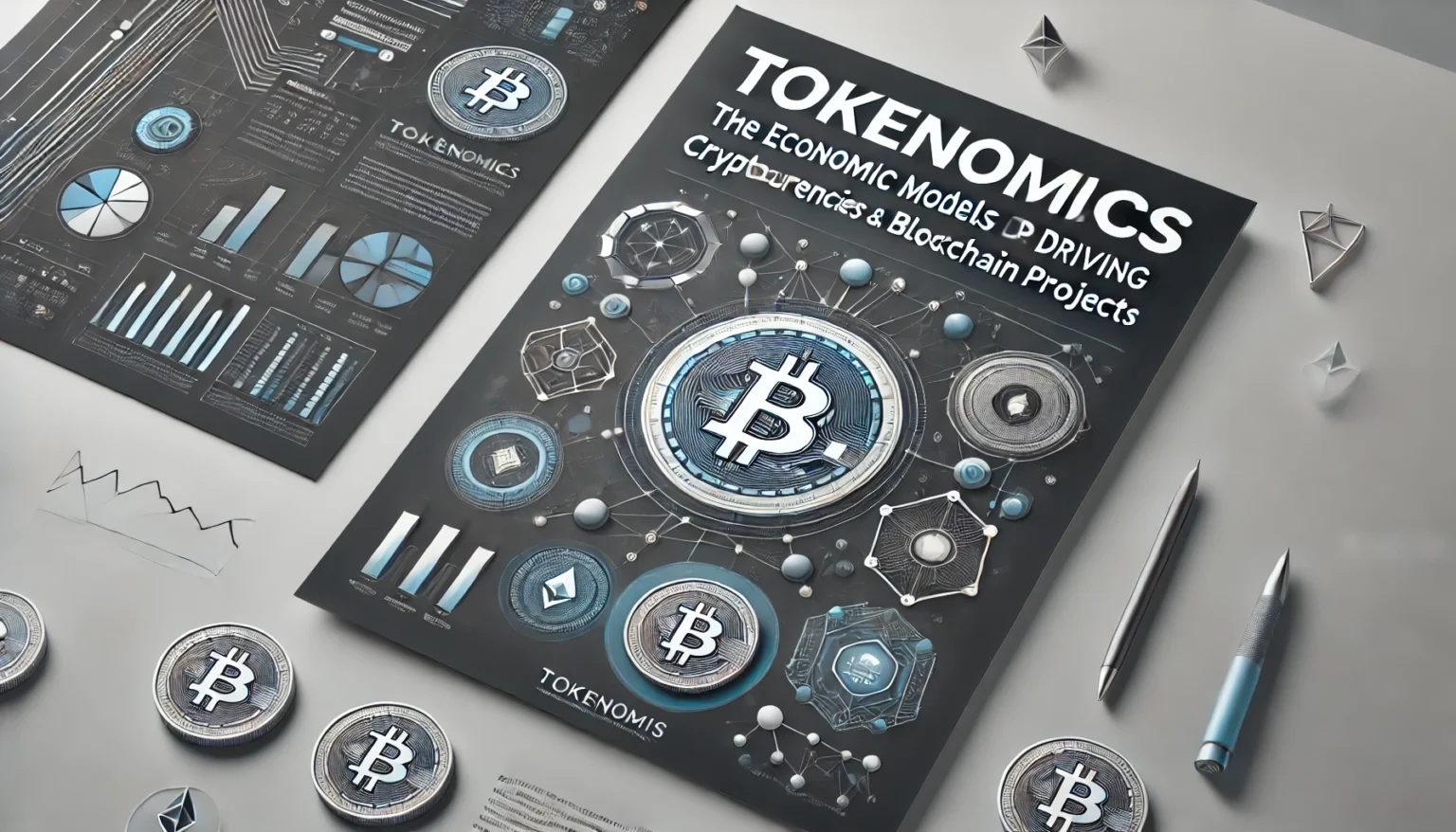In the world of cryptocurrency and blockchain technology, the term “tokenomics” has emerged as a critical factor for understanding the financial aspects of these decentralized systems. Tokenomics refers to the economic models and structures that define how digital tokens or cryptocurrencies function within a blockchain ecosystem. It plays a significant role in determining the success, sustainability, and value of a project, influencing everything from investor interest to the adoption of a particular cryptocurrency. This article dives into the different components of tokenomics and how they shape the future of blockchain projects.

What Is Tokenomics?
Tokenomics is a blend of “token” and “economics,” referring to the economic principles and models that govern the creation, distribution, and management of tokens within a blockchain-based project. In simpler terms, it is the study of the design and structure of tokens, including their supply, demand, utility, and how they interact within the broader ecosystem. Every cryptocurrency project, whether it’s Bitcoin, Ethereum, or a smaller altcoin, relies on a specific set of tokenomics to drive its network and encourage user participation. A well-designed tokenomics model can help a project succeed, while a flawed one can cause it to fail.
At the core of tokenomics are several key elements: token supply, demand, utility, and governance. These factors are interconnected and work together to shape the behavior of investors, users, and developers within the ecosystem. The value of a token often depends on how well these elements are balanced, with an ideal model fostering long-term growth, utility, and sustainability. Let’s explore these elements further to understand how they work.
The Importance of Token Supply and Demand
Token supply and demand form the foundation of any successful tokenomics model. The supply of tokens refers to the total number of tokens available in circulation, while demand represents how much users are willing to pay for them. These two factors play a crucial role in determining the value of a cryptocurrency. If the supply of tokens exceeds demand, the value of the token will likely decrease. Conversely, if the demand outpaces supply, the token’s value can increase.
In most blockchain projects, there are mechanisms in place to control token supply. Some projects have a fixed supply, like Bitcoin, which has a maximum supply of 21 million coins. Others, like Ethereum, have a more flexible supply model, allowing for ongoing issuance through mining or staking. The control over supply ensures that inflation is kept in check and that the token’s value doesn’t become devalued over time. On the demand side, factors such as the utility of the token, the adoption rate, and the overall market sentiment can all influence how valuable a token is.
Types of Token Models
Cryptocurrencies and blockchain projects use various token models, each designed to serve specific purposes. The three main types of token models are utility tokens, security tokens, and governance tokens. Each of these token types has its own unique role and function within the ecosystem, influencing the overall tokenomics of a project.
Utility tokens are the most common type of token used in blockchain projects. These tokens are created to provide users with access to the services or products offered by the platform. For example, Ethereum’s Ether (ETH) is a utility token that is used to pay for transaction fees and computational services on the Ethereum network. Security tokens, on the other hand, represent ownership in an underlying asset, such as stocks, bonds, or real estate. These tokens are subject to regulatory oversight and are used for investment purposes. Finally, governance tokens give holders the power to vote on changes to the project’s protocol, making them a crucial part of decentralized governance systems.
The Role of Token Utility
Token utility is a central element of tokenomics. A token’s utility refers to its function within a given blockchain ecosystem. Utility tokens allow users to perform specific actions on the network, whether it’s paying transaction fees, accessing features, or participating in governance. Without utility, a token has no real use case, which can result in low demand and a decrease in value.
For example, in the case of the Ethereum network, Ether (ETH) is used to pay for gas fees, which are required to execute transactions or smart contracts. This creates demand for the token, as users must acquire ETH in order to interact with the network. Similarly, in decentralized finance (DeFi) platforms, utility tokens are often used for lending, borrowing, or staking, providing incentives for users to participate. The more essential the token is for the functioning of the platform, the higher its perceived value, which ultimately drives adoption and long-term success.
Token Distribution Models
How tokens are distributed is another crucial aspect of tokenomics. A blockchain project’s token distribution model determines who gets access to the tokens, when, and how. These models can vary significantly, with some projects choosing to issue tokens through initial coin offerings (ICOs), airdrops, or token sales, while others may rely on mining or staking rewards.
The distribution model impacts how the token circulates within the market. A fair distribution ensures that a wide variety of users can participate in the ecosystem, leading to increased decentralization and a more robust network. Conversely, an unfair or overly centralized distribution, where a small group of individuals hold the majority of tokens, can lead to market manipulation and a lack of trust in the project. A well-designed distribution model also takes into account the timing of token releases, avoiding market oversaturation and ensuring that the token’s value is protected over time.
Staking and Yield Farming
Staking and yield farming are two popular methods used in blockchain ecosystems to incentivize users to hold and lock up their tokens, thereby contributing to the network’s security and liquidity. Staking involves holding tokens in a wallet to support the operations of a proof-of-stake (PoS) blockchain, where users are rewarded with additional tokens for participating in network consensus. Yield farming, on the other hand, involves providing liquidity to decentralized exchanges or lending platforms in exchange for rewards.
Both staking and yield farming provide important incentives for users to engage with the platform and contribute to the network’s growth. These mechanisms create a supply-demand loop, where the more tokens that are staked or locked up, the scarcer they become in circulation, which can lead to an increase in token value. For blockchain projects, staking and yield farming help to maintain a healthy and active ecosystem, which is vital for the project’s long-term success.
Token Burn Mechanisms
A token burn mechanism is a strategy used to reduce the total supply of tokens in circulation. Token burning involves sending a certain number of tokens to a wallet address from which they cannot be retrieved, effectively removing them from the circulating supply. This process can help counteract inflation and increase scarcity, which in turn can increase the value of the remaining tokens.
Token burns are often implemented as part of a project’s tokenomics strategy to maintain a balanced supply and demand dynamic. Some projects introduce periodic token burns, while others may burn tokens in response to specific milestones or events, such as reaching a certain amount of transaction volume. The transparency of token burn events can also increase trust within the community, as users can see the impact of the burn on the overall token supply.
Inflation vs. Deflation in Tokenomics
The concepts of inflation and deflation are key to understanding tokenomics. In traditional economics, inflation refers to the decrease in the value of money over time, often due to an increase in supply. Similarly, in cryptocurrency markets, inflation occurs when the supply of a token grows faster than demand, which can lead to a reduction in the token’s value. On the other hand, deflation refers to a decrease in the token supply, often resulting in an increase in the token’s value due to scarcity.
Managing inflation and deflation is an important consideration for any blockchain project. Inflationary models, such as those seen in fiat currencies, can lead to a loss of value over time, while deflationary models can create a sense of scarcity, driving up demand. Many cryptocurrency projects attempt to strike a balance between these two forces by implementing measures such as fixed supply caps, token burns, and staking rewards.
Governance and Decentralized Decision-Making
Decentralized governance is a core principle of blockchain technology, and governance tokens are the key to making this system work. Governance tokens give holders the power to participate in decisions about the future direction of the project. This can include decisions on protocol upgrades, changes to the tokenomics model, or the allocation of funds within the project. By distributing governance tokens to the community, blockchain projects can ensure that no single entity has control over the network, fostering a more democratic and decentralized decision-making process.
The role of governance tokens is critical to the sustainability of a project, as it empowers the community to take part in shaping the future of the ecosystem. This decentralized approach ensures that the project remains aligned with the interests of its users and prevents any central authority from making unilateral decisions that could negatively impact the network.
The Impact of Tokenomics on Market Sentiment
Tokenomics has a direct influence on market sentiment, which can drive the price of a cryptocurrency up or down. If investors believe that a project’s tokenomics model is strong, with a balanced supply-demand dynamic, clear utility, and incentives for participation, they are more likely to invest in the project. Conversely, if a project’s tokenomics model is poorly designed or lacks transparency, investors may be hesitant to put their money into it, leading to a decrease in market interest.
Understanding tokenomics is essential for investors looking to make informed decisions about which cryptocurrencies to buy and hold. By analyzing factors such as token supply, demand, distribution models, and utility, investors can gain insights into the long-term potential of a project and make better investment choices.
The Role of Community in Tokenomics
The success of a blockchain project often depends on the strength and engagement of its community. A strong, active community can help drive adoption, contribute to governance decisions, and create demand for the project’s token. Tokenomics plays a significant role in community engagement by
providing incentives for users to participate in the network. This can include rewards for staking, liquidity provision, or voting on governance proposals.
A project’s tokenomics model must align with the values and needs of its community. If users feel that they are being fairly rewarded for their contributions, they are more likely to remain active participants. Conversely, if the tokenomics model feels exploitative or unfair, the community may lose trust in the project, leading to a decline in participation and value.
Regulatory Considerations in Tokenomics
As the cryptocurrency market grows, so does the need for regulatory oversight. Many governments and financial authorities are beginning to take a closer look at tokenomics models to ensure that they are compliant with existing laws. For example, security tokens are subject to securities regulations, while utility tokens may be subject to different rules depending on their usage.
Regulation plays a crucial role in shaping the future of tokenomics. Projects that fail to comply with regulatory standards risk facing legal challenges, fines, or even shutdowns. On the other hand, projects that adhere to regulations can build trust with investors and users, ensuring the long-term sustainability of their tokenomics models. As the regulatory landscape continues to evolve, projects must stay informed and adapt their tokenomics strategies accordingly.
The Future of Tokenomics
The field of tokenomics is still relatively new, and as blockchain technology evolves, so too will the models that govern it. The rise of decentralized finance (DeFi), non-fungible tokens (NFTs), and other innovative applications of blockchain will likely lead to new and unique tokenomics models. As the industry matures, we can expect to see more sophisticated models that integrate factors such as sustainability, scalability, and interoperability.
For tokenomics to thrive, it will need to adapt to changing market conditions, technological advancements, and regulatory developments. Projects that can effectively balance the various elements of tokenomics—supply, demand, utility, governance, and community—will be best positioned for success in the rapidly evolving world of blockchain technology.
Conclusion
Tokenomics is a vital aspect of cryptocurrency and blockchain projects that defines the economic model behind each token. From supply and demand to token utility, distribution, and governance, every element of tokenomics plays a role in the success of a blockchain project. By understanding how tokenomics works, both users and investors can make informed decisions about the potential of a given cryptocurrency. As the industry continues to evolve, tokenomics will remain a key driver of innovation, growth, and sustainability in the world of digital assets.
1. What is Tokenomics, and why is it important in cryptocurrency projects?
Tokenomics, short for “token economics,” refers to the economic structure and design of a cryptocurrency or blockchain project. It covers the supply, distribution, and incentivization of tokens to create value and drive user engagement. Strong tokenomics are crucial because they encourage adoption, stabilize token value, and support long-term project sustainability.
2. How do token supply and demand affect the value of a cryptocurrency?
Token supply and demand are central to tokenomics. A limited or deflationary supply (like Bitcoin) can increase demand and value as scarcity grows. Conversely, if there is an excessive supply without strong demand, a token may lose value. Balancing these factors is essential for maintaining a token’s price and attracting investors.
=
3. What are some common economic models used in blockchain projects?
Common economic models include staking, burning, and yield farming. Staking encourages users to hold and secure the network by offering rewards, while burning reduces token supply to increase scarcity. Yield farming allows users to earn more tokens by providing liquidity, incentivizing engagement and token usage within the ecosystem.
Know more
The Rise of Non-Fungible Tokens (NFTs): Beyond Art and Collectibles
The Impact of Regulatory Changes on Cryptocurrency Markets in 2024
AI and Blockchain: A Powerful Combination Transforming Industries in 2024
Our Other site


